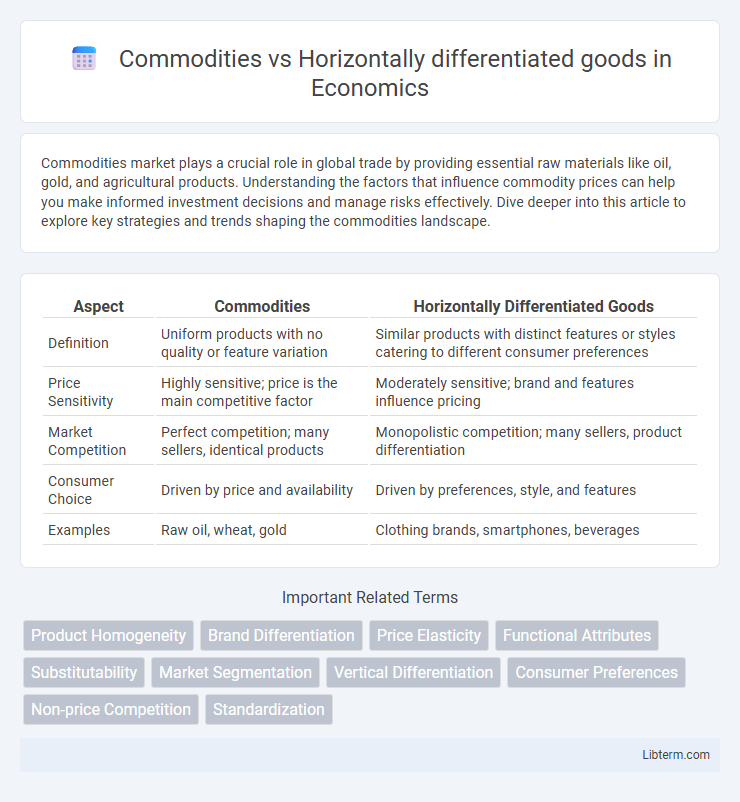Commodities market plays a crucial role in global trade by providing essential raw materials like oil, gold, and agricultural products. Understanding the factors that influence commodity prices can help you make informed investment decisions and manage risks effectively. Dive deeper into this article to explore key strategies and trends shaping the commodities landscape.
Table of Comparison
| Aspect | Commodities | Horizontally Differentiated Goods |
|---|---|---|
| Definition | Uniform products with no quality or feature variation | Similar products with distinct features or styles catering to different consumer preferences |
| Price Sensitivity | Highly sensitive; price is the main competitive factor | Moderately sensitive; brand and features influence pricing |
| Market Competition | Perfect competition; many sellers, identical products | Monopolistic competition; many sellers, product differentiation |
| Consumer Choice | Driven by price and availability | Driven by preferences, style, and features |
| Examples | Raw oil, wheat, gold | Clothing brands, smartphones, beverages |
Introduction to Commodities and Horizontally Differentiated Goods
Commodities are standardized products with little to no variation in quality, making them interchangeable and typically priced based on market supply and demand. Horizontally differentiated goods vary in attributes such as style, brand, or features, appealing to different consumer preferences without implying quality differences. These differences create product niches and allow firms to compete on factors beyond price, such as consumer taste and brand loyalty.
Defining Commodities: Key Characteristics
Commodities are standardized products that are uniform in quality and interchangeable regardless of the producer, such as crude oil or wheat, leading to price-driven competition in markets. Key characteristics include homogeneity, fungibility, and widespread availability, making brand or origin irrelevant to consumers. This contrasts with horizontally differentiated goods, which vary in attributes like style or location preference but often target diverse consumer tastes rather than uniform quality.
What are Horizontally Differentiated Goods?
Horizontally differentiated goods are products that serve the same basic function but vary in attributes such as style, brand, or features to appeal to different consumer preferences. Unlike commodities, which are largely identical and interchangeable, horizontally differentiated goods emphasize variety and consumer choice without significant differences in quality. Examples include various flavors of soda or different clothing brands that offer diversity in design and appeal rather than performance.
Price Competition: Commodities vs Horizontal Differentiation
Price competition among commodities is intense due to the products' homogeneity, leading firms to compete primarily on price to capture market share. In contrast, horizontally differentiated goods allow firms to charge higher prices based on unique features, brand identity, or consumer preferences, reducing direct price rivalry. This differentiation softens price competition as consumers value variety and are less likely to switch solely based on price changes.
Consumer Choice and Product Attributes
Commodities are products with uniform quality and minimal differentiation, leading consumer choice to depend primarily on price and availability. Horizontally differentiated goods vary in attributes such as style, color, or features that cater to diverse consumer preferences, making subjective taste a key driver in purchasing decisions. Consumers evaluate product attributes beyond price, emphasizing personal identity and satisfaction in markets for horizontally differentiated goods.
Market Structure and Competitive Dynamics
Commodities are standardized products with little to no differentiation, leading to perfectly competitive or oligopolistic market structures where price competition dominates and firms are price takers. Horizontally differentiated goods, characterized by varied consumer preferences despite similar quality levels, create monopolistic competition or differentiated oligopoly markets, enabling firms to exercise pricing power through product variety. Competitive dynamics in commodity markets revolve around cost efficiency and scale, whereas in horizontally differentiated markets, firms compete on branding, features, and niche targeting to capture specific consumer segments.
Role of Branding in Horizontally Differentiated Markets
In horizontally differentiated markets, branding plays a crucial role by signaling unique product attributes that appeal to consumer preferences, allowing firms to compete beyond price. Unlike commodities, where products are largely interchangeable, strong branding creates perceived value and loyalty through distinct features, quality, or style. As a result, firms leverage branding strategies to achieve market segmentation and reduce price elasticity.
Supply Chain Considerations for Both Product Types
Commodities require supply chains optimized for efficiency, bulk handling, and cost reduction due to their standardized nature and high price sensitivity. Horizontally differentiated goods demand flexible supply chains capable of managing diverse product variants, customization, and rapid response to consumer preferences. Inventory management, production scheduling, and distribution logistics must adapt to the uniformity of commodities or the heterogeneity of differentiated goods to maintain competitive advantage.
Profit Margins and Business Strategies
Commodities typically exhibit low profit margins due to standardization and intense price competition, driving businesses to focus on cost leadership and operational efficiency. Horizontally differentiated goods allow firms to command higher profit margins by targeting niche markets with unique features or branding, enabling strategies centered on product differentiation and customer loyalty. These strategic approaches significantly impact revenue models, with commodity firms relying on volume sales and differentiated product firms emphasizing value creation and premium pricing.
Future Trends in Commodity and Differentiated Goods Markets
Emerging technologies and sustainability initiatives are driving innovation in both commodity and horizontally differentiated goods markets, pushing producers to enhance quality and traceability. The rise of digital platforms and advanced analytics enables better market segmentation, allowing differentiated goods to command premium prices while commodities benefit from improved supply chain transparency. Increasing consumer preference for personalized and eco-friendly products is expected to expand the demand for differentiated goods, whereas commodities will face pressures to adopt sustainable practices and stabilize price volatility through futures trading.
Commodities Infographic

 libterm.com
libterm.com